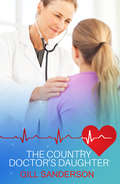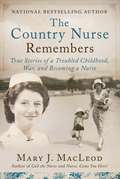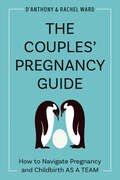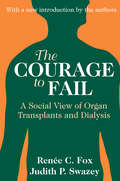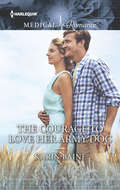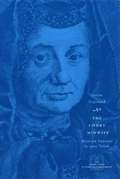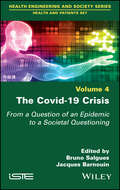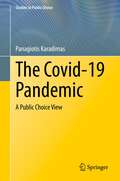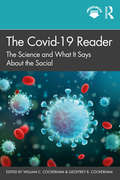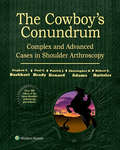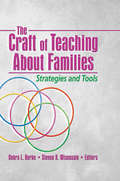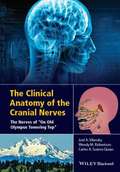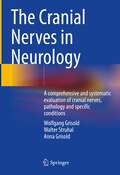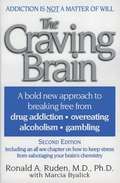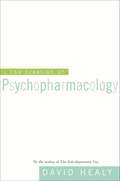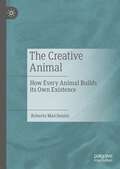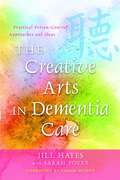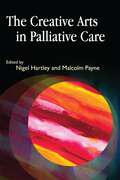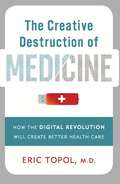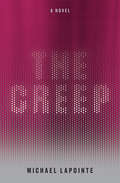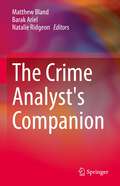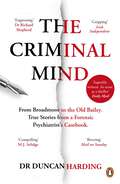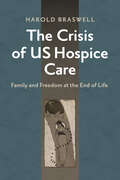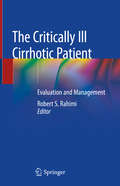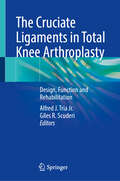- Table View
- List View
The Country Doctor's Daughter: A Heartwarming Medical Romance (Medical Romances #17)
by Gill SandersonAnother heartwarming medical romance from best-selling author Gill Sanderson! Perfect for fans of Mia Faye, Laura Scott, Helen Scott Taylor, Grey's Anatomy and ER.Readers ADORE Gill's gripping medical romances!'Remarkable writer!!' 5* author review 'A truly wonderful writer' 5* author review 'I find all of Gill Sanderson's books very readable and enjoy the escapism they give me' 5* author review 'A truly gifted writer with an enormous amount of talent and sensitivity' 5* author review Dr Kelly Blackman had come to Brittany to act as a locum doctor for three months. After the trauma she had suffered she needed time and peace to ensure that both body and mind were as good as they had been.She enjoyed working with Dr Luc Laforge and tried to ignore the occasional realisation that he was a very attractive man. Was he interested in her? It was hard to tell. And she did not want another catastrophic love affair. Perhaps though, there was an odd bond between them. Luc had suffered from an unsuccessful marriage. Now they both were cautious. Of all things it was Luc's daughter Jenny that brought them together, made them see that they were made for each other.Don't miss Gill Sanderson's enthralling medical romances, including the A Lakeland Practice and the Good, Bad and Ugly series.
The Country Nurse Remembers: True Stories of a Troubled Childhood, War, and Becoming a Nurse (The Country Nurse Series, Book Three) (The Country Nurse #3)
by Mary J. MacLeodFrom the Bestselling Author of Call the Nurse and Nurse, Come You Here!, the Moving Story of Her Young Life and Her Path to Independence through Training to Be a Nurse—"A Must-Read Suggestion for Fans of the BBC's Call the Midwife" (Booklist) Mary MacLeod's mother died in childbirth when Mary was five, an event that marked for the child a "before time"—a lost joyful time—and after. She was shunted from one relative to another while her father coped with his grief. He married again only nine months later, perhaps to have a mother for his child, but her new mum, harsh and withholding of her love, quickly exerted complete control over her thoughts and deeds, with her father oblivious. Her name was changed to her stepmother's choice of "Julia." Yet the pale, thin, quiet little girl didn't know she was unhappy: things were just the way they were. Narrating from the perspective of the child she was but with the understanding and empathy of the nurse and mother she became, the author of Call the Nurse recounts the moving, intimate, indelible story of her young life, growing up in rural England near Bath, relishing the good times when her stepmother was friendly or she helped her father in the garden, experiencing the world war—air raids and blackouts, the war effort, evacuees, German prisoners—winning a scholarship, leaving home to train for three years as a nurse, and gradually finding her way as an independent woman.
The Couples' Pregnancy Guide: How to Navigate Pregnancy and Childbirth as a Team
by Rachel Ward D'Anthony WardPractical strategies, checklists, and planning tools to help couples navigate the pregnancy, childbirth, and newborn stages togetherPreparing for the birth of your child is a life-changing experience, but it doesn&’t have to be an overwhelming one. Couples can tackle everything that needs to get done if they work together as a team, all while setting the foundation for a strong partnership that carries them through the next stage as first-time parents. The Couples' Pregnancy Guide offers supportive advice, strategies, and checklists couples need to create a plan that works for their unique relationship. There&’s no script for how things will go in pregnancy, but you can get through it with confidence and optimism when you do it together. The Couples' Pregnancy Guide features: • A month-by-month breakdown of discussion-worthy topics, from prenatal screenings and parental leave to childcare options and birth plans • Guidance on how to support your partner to improve communication, strengthen emotional attunement, and lay the groundwork for a strong parenting team •Checklists and worksheets to share responsibilities and empower non-birthing partners, and brainstorm solutions when joint decisions are particularly tricky •Practical advice for challenges like easing tight finances, moving past communication impasses, and advocating for yourself in medical settings
The Courage to Fail: A Social View of Organ Transplants and Dialysis
by Judith P. SwazeyThe title of this profound work conveys the bold, uncertain, and often dangerous adventure in which medical professionals and their organ transplant and dialysis patients are engaged. Built around a series of case studies, The Courage to Fail is the product of collaborative first-hand research concerned with various social phenomena generated by transplantation and dialysis. The authors examine the individuals involved and the workings and atmosphere of some of the medical centers in which these forms of therapy have been developed. They examine ""gift-exchange"" dimensions of transplantation: the transcendent and tyrannical aspects of the ""gift of life"" that transplants entail for donors and recipients-and for medical professionals as well. They also analyze the dilemma of uncertainty inherent in medicine, which occurs with particular force in the development of such experimental techniques.Since publication of the original edition, the authors have continued to follow social and medical developments surrounding organ transplants and dialysis. In their new introduction, they discuss transplantation as a gift of life, how and when death occurs, efforts to procure more organs, and organ replacement and issues of equity. This book will be of interest to physicians, medical students, medical sociologists, and anyone interested in the history of and issues surrounding organ transplantation and dialysis.
The Courage to Love Her Army Doc
by Karin BaineTaking chances Dr. Joe Braden took a posting as locum on a remote Fijian island to escape his memories. But he finds the solace he seeks in the unlikeliest of places...the arms of captivating Dr. Emily Clifford. Born with a distinctive birthmark, Emily has spent years hidden behind a mask of makeup. Yet Joe makes her feel beautiful in her skin for the first time ever. She's been burned before, but if she can find the courage to love her army doc she can claim the happy-ever-after she's dreamed of...
The Court Midwife
by Justina Siegemund Lynne TatlockThe Court Midwife contains descriptions of obstetric techniques of midwifery and its attendant social pressures and riveting birthing scenes, sworn testimonials by former patients, and a brief autobiography.
The Covid-19 Crisis: From a Question of an Epidemic to a Societal Questioning, Volume 4
by Bruno Salgues Jacques BarnouinThe threats of emerging diseases have shaken certainties about health systems, the effectiveness of governance, lifestyles and the reality of national sovereignty.The Covid-19 Crisis analyzes the global issues related to the emergence of the SARS-CoV-2 virus through investigations and reflections related to both the epidemic itself (epidemiology, computerized surveillance tools and vaccines) and to the societal issues it raises (work, innovation, religious practices, behaviors and societal models).This eclectic approach highlights scientific working methods that meet the requirements of health crises, as well as technical solutions and societal practices adapted to epidemic situations. It also presents feedback and testimonies.
The Covid-19 Pandemic: A Public Choice View (Studies in Public Choice #42)
by Panagiotis KaradimasThis monograph evaluates public policy responses to the Covid-19 pandemic through a public choice lens. The book compares two prominent, albeit mutually exclusive, theories in social sciences—public interest theory and public choice theory—and explores how their predictions perform within the framework of the Covid-19 pandemic. The chapters present different pandemic policies alongside empirical data in order to draw conclusions about their efficacy, and, in turn, draw conclusions about the veracity of each theory. By the end of the volume, the reader will be able to draw their own conclusions about whether the pandemic policy responses served the public interest, as public interest theory suggests, or the personal interests of the politicians who implemented them, as public choice theory holds.
The Covid-19 Reader: The Science and What It Says About the Social
by William C. Cockerham; Geoffrey B. CockerhamThis reader offers some of the most important writing to date from the science of COVID-19 and what science says about its spread and social implications. The readings have been carefully selected, introduced, and interpreted for an introductory or graduate student readership by a distinguished medical sociology and political science team. While some of the early science was inaccurate, lacking sufficient data, or otherwise incomplete, the author team has selected the most important and reliable early work for teachers and students in courses on medical sociology, public health, nursing, infectious diseases, epidemiology, anthropology of medicine, sociology of health and illness, social aspects of medicine, comparative health systems, health policy and management, health behaviors, and community health. Global in scope, the book tells the story of what happened and how COVID-19 was dealt with. Much of this material is in clinical journals, normally not considered in the social sciences, which are nonetheless informative and authoritative for student and faculty readers. Their selection and interpretation for students makes this concise reader an essential teaching source about COVID-19. An accompanying online resource on the book’s Routledge web page will update and evolve by providing links to new readings as the science develops.
The Cowboy's Conundrum: Complex And Advanced Cases In Shoulder Arthroscopy
by Stephen S. BurkhartObtain optimal outcomes with masterful guidance! The Cowboy’s Conundrum: Complex and Advanced Cases in Shoulder Arthroscopy brings you step-by-step advice from preeminent orthopaedic surgeons, helping you to successfully perform even the most challenging techniques and achieve the best results. Authored by Stephen S. Burkhart, MD and his expert team of surgeons, creators of bestselling titles A Cowboy’s Guide to Advanced Shoulder Arthroscopy and The Cowboy’s Companion: A Trail Guide for the Arthroscopic Shoulder Surgeon, The Cowboy’s Conundrum brings you the collective wisdom of world authorities who have been intimately involved in pioneering and refining today’s approaches to minimally invasive shoulder surgery. Dr. Burkhart uses his trademark “cowboy” flair to communicate essential clinical pearls in an approachable and entertaining manner.
The Craft of Teaching About Families: Strategies and Tools
by Debra L. Berke Steven K. WisensaleLearn how to develop and teach effective courses on the vital issues of family lifeThe Craft of Teaching About Families presents a variety of course designs, evaluation methods, and teaching techniques and strategies that can be used to address the complexities of family life. This unique book prepares students for the challenges they&’ll face as they leave the campus for the classroom, providing them with the problem-solving skills they&’ll need for success. The book&’s contributors-a distinguished panel of family scientists, sociologists, public policy analysts, psychologists, and extension specialists-examine a range of topics, including family law and policy, advocacy, parenting skills, international families, and diversity.One of the few books geared to teaching family studies, particularly family policy and family law, The Craft of Teaching About Families reaffirms the importance of teaching in a time when controversial family issues receive constant attention from the media, the courts, and the legislatures. In addition to articles on family policy, family law, marriage and the family, family interaction and dynamics, and cultural diversity, the book addresses empirical assessments of internships and service learning activities in family-oriented courses, the effectiveness of various teaching strategies, including role-playing, classroom simulations, and Web-based assignments. Divided into three sections for ease of use, The Craft of Teaching About Families examines:Family Law and Family Policy how to build writing skills through the preparation of court briefs and policy memos how to use cooperative learning research teams to teach family law how to design better courses by understanding students&’ perceptions of family policy issues how cooperative extension can help involve families in the policymaking processFamily Dynamics how to develop a course in father-daughter relationships how to incorporate parenting education workshops into a parent-child relationship course how to prepare students to become competent multicultural educators how to develop a course on international families from a family strengths perspective how to develop a new framework for teaching family resources managementTeaching Techniques in Family Science how to incorporate effective role-playing into the syllabus how to use small-group work to create a positive experience in the classroom how to educate future teachers about psychological abuse how to teach students about forgiveness toward those who have hurt them how to analyze the results of service-learning assignments in family diversityThe Craft of Teaching About Families is an essential resource for professionals who teach about individuals and families at any level, in any setting-formal or informal.
The Cranial Nerves
by Joel A. Vilensky Carlo A. Suarez-Quian Wendy RobertsonThe cranial nerves are an endlessly fascinating family of twelve nerves that have a dramatic impact on our daily lives. A dysfunction of the cranial nerves can cause loss of vision or double vision, loss of smell, poor balance, or loss of muscle function, and can also be an indicator of underlying neurological disorders. The Clinical Anatomy of the Cranial Nerves: The Nerves of "On Old Olympus Towering Top" is an engaging and accessible book on the anatomy and clinical importance of these unique nerves.. Thetext opens with a brief introduction of key neuroanatomical concepts that relate the clinical and anatomical sections that follow. Additionally, this book uniquely provides a detailed description of the bones of the head and face in order for the reader to understand the routes taken by the cranial nerves through the skull. Chapters then detail each nerve and its unique impact in relationship to our senses, motor function, and health. Vividly illustrated and supported by real-life clinical cases, the book will appeal to anyone wishing to gain a better understanding of the cranial nerves. Merging anatomical and clinical information with intriguing clinical cases, The Clinical Anatomy of the Cranial Nerves: The Nerves of "On Old Olympus Towering Top" introduces readers to the anatomy and diverse function of this intriguing family of nerves.
The Cranial Nerves in Neurology: A comprehensive and systematic evaluation of cranial nerves, pathology and specific conditions
by Wolfgang Grisold Walter Struhal Anna GrisoldThis book presents a complete summary about the 12 pairs of cranial nerves (CN). They control much of the motor and sensory functions of the head and neck such as smell, sight, eye movement, and feeling in the face. The CN also control balance, hearing, and swallowing. The examination of the CN is an important part of the clinical neurological examination. Additionally, to the anatomy, extensive knowledge about further diagnostic tools are necessary such as neuroimaging, and electrophysiology. The book is divided into three parts: a general part with anatomy and imaging, a systematic part grouping the 12 pairs of cranial nerves, and a part describing cranial nerve functions in specific conditions and diseases.
The Craving Brain: A Bold New Appraoch to Breaking Free from Drug Addiction, Overeating, Alcoholism, Gambling (Second Edition)
by Marcia Byalick Ronald A. RudenIn the Craving Brain, Dr. Ronald Ruden asserts that the roots of addiction most definitely do not lie in our character. Rather, they lie in a complex chain reaction that originates in an ancient survival mechanism in the brain. When this system is inappropriately activated, it drives the body to crave, sometimes with addictive behavior as the end result. In clear, straightforward language, Dr. Ruden outlines his remarkable successful treatment program which he believes can cure this problem. The Craving Brain offers crucial insights into the world of addiction. This revolutionary book will bring hope to millions of people who suffer from a wide range of addictions, from gambling and alcohol to drugs and food.
The Creation of Psychopharmacology
by David HealyDavid Healy follows his widely praised study, The Antidepressant Era, with an even more ambitious and dramatic story: the discovery and development of antipsychotic medication. Healy argues that the discovery of chlorpromazine (more generally known as Thorazine) is as significant in the history of medicine as the discovery of penicillin, reminding readers of the worldwide prevalence of insanity within living memory. But Healy tells not of the triumph of science but of a stream of fruitful accidents, of technological discovery leading neuroscientific research, of fierce professional competition and the backlash of the antipsychiatry movement of the 1960s. A chemical treatment was developed for one purpose, and as long as some theoretical rationale could be found, doctors administered it to the insane patients in their care to see if it would help. Sometimes it did, dramatically. Why these treatments worked, Healy argues provocatively, was, and often still is, a mystery. Nonetheless, such discoveries made and unmade academic reputations and inspired intense politicking for the Nobel Prize. Once pharmaceutical companies recognized the commercial potential of antipsychotic medications, financial as well as clinical pressures drove the development of ever more aggressively marketed medications. With verve and immense learning, Healy tells a story with surprising implications in a book that will become the leading scholarly work on its compelling subject.
The Creative Animal: How Every Animal Builds its Own Existence
by Roberto MarchesiniThis book deals with the theme of creativity in the animal world, conceived as a basic function for adapting to specific situations and as a source of innovations and inventions. Creativity is a fundamental resource for the individual who always has a leading role in conduct. To explain creativity, the book focuses on the concept of animal subjectivity, providing a new explanatory model of behavior capable of overcoming the image of the animal moved by automatisms. This model does not use consciousness as a necessary condition, but is based: 1) on affective components, such as behavioral motives, and 2) cognitive, as tools used by the subject to carry out his purposes. Particular attention is paid to the learning processes showing the subjective character of the experience. One topic addressed is the role of creativity in the evolution of living beings: how an invention, by modifying the niche characteristics, is able to change the selective pressures and the trajectory of phylogeny. Roberto Marchesini explains that creativity is a factor that is anything but rare or exceptional in the animal world—it constitutes a fundamental quality for many aspects of animal life.
The Creative Arts in Dementia Care
by Jill Hayes Sarah PoveyThe physical care of people with dementia is of vital importance, but so too is their emotional, social, mental and spiritual wellbeing. The creative arts are gaining increasing recognition not only as a tool for delivering effective person-centred dementia care, but also for attending to soul as well as body. Encouraging those who care for people with dementia to develop their own creative skills, this book provides a creative map of care with easy-to-follow examples and detailed case studies. After explaining why adopting a creative approach is central to effective dementia care, the authors go on to discuss meditation, singing, movement and storytelling, describing the therapeutic benefits of each and giving practical examples of how they can be used with individuals or groups. They also look at the importance of creative supervision in promoting creativity and creating a safe space for honest interpersonal connection: an essential foundation for effective teamwork. This book will be an invaluable resource for anyone involved in the care of a person with dementia, including professional staff in residential and nursing homes, hospitals and day centres, families and other non-professional carers.
The Creative Arts in Palliative Care
by Nigel Hartley Sam Dobbs Adrian Butchers Malcolm Payne Abi GillUse of the arts in palliative care settings is a powerful and effective way of addressing the practical, psychological, social and spiritual issues faced by service users in end-of-life care. The Creative Arts in Palliative Care uncovers the possibilities for using the creative arts and provides guidance on how to implement arts projects successfully. Part 1 focuses on designing objectives for the creative arts in palliative care - such as self-fulfilment, social participation, diversion from pain and other common symptoms - and managing creative arts services. Part 2 demonstrates the theory and principles in practice, with detailed case studies: each chapter draws on a real-life project, the approaches it employed and the outcomes achieved. This book will be essential reading for healthcare professionals, arts practitioners and all those involved in providing palliative care services.
The Creative Destruction of Medicine: How the Digital Revolution Will Create Better Health Care
by Eric TopolWhat if your cell phone could detect cancer cells circulating in your blood or warn you of an imminent heart attack? Mobile wireless digital devices, including smartphones and tablets with seemingly limitless functionality, have brought about radical changes in our lives, providing hyper-connectivity to social networks and cloud computing. But the digital world has hardly pierced the medical cocoon. Until now. Beyond reading email and surfing the Web, we will soon be checking our vital signs on our phone. We can already continuously monitor our heart rhythm, blood glucose levels, and brain waves while we sleep. Miniature ultrasound imaging devices are replacing the icon of medicine--the stethoscope. DNA sequencing, Facebook, and the Watson supercomputer have already saved lives. For the first time we can capture all the relevant data from each individual to enable precision therapy, prevent major side effects of medications, and ultimately to prevent many diseases from ever occurring. And yet many of these digital medical innovations lie unused because of the medical community's profound resistance to change. In The Creative Destruction of Medicine, Eric Topol--one of the nation's top physicians and a leading voice on the digital revolution in medicine--argues that radical innovation and a true democratization of medical care are within reach, but only if we consumers demand it. We can force medicine to undergo its biggest shakeup in history. This book shows us the stakes--and how to win them.
The Creep
by Michael LaPointe"A deep, weird and uncanny tale" —Sheila Heti"A book to devour"—Iain Reid"Sinister good fun" —Lee Henderson"Gripping and unassumingly smart" —Lauren Oyler A journalist with a history of bending the facts uncovers a story about a medical breakthrough so astonishing it needs no embellishment--but behind the game-changing science lies a gruesome secret.A respected byline in the culture pages of the venerable New York magazine The Bystander, journalist Whitney Chase grapples with a mysterious compulsion to enhance her coverage with intriguing untruths and undetectable white lies. She calls it "the creep"--an overpowering need to improve the story in the telling. And she has a particular genius for getting away with it.In the immediate aftermath of 9/11, Whitney yearns to transition from profiling rock stars and novelists to covering the stories that "really matter." When a chance encounter brings her face-to-face with a potentially massive story about a game-changing medical discovery, Whitney believes she's finally found a story that doesn't need any enhancement. The brilliant and charismatic doctor behind the breakthrough claims she's found "the Holy Grail of medical science": a synthetic blood substitute that, if viable, promises to save millions of lives, and make her corporate backers rich beyond measure. But when Whitney's investigation of this apparent medical miracle puts her on the trail of a string of grisly fatalities across the country, she becomes inexorably tied to a much darker and more nefarious story than even she could imagine. Set against the ramp-up to the US invasion of Iraq and the decline of print journalism, Michael LaPointe's panoramic, ingeniously plotted debut paints an affecting portrait of an increasingly unequal twenty-first century, exploring how deceitfulness, self-enhancement, and confidently delivered lies can be transfused into fact and constitute a broader violence against the social fabric and public trust.
The Crime Analyst's Companion
by Barak Ariel Matthew Bland Natalie RidgeonThis volume presents a collection of essays from experienced crime analysts from around the world. It explores themes relevant to anyone embarking on, or already into a career in crime analysis. Divided into two sections, this book addresses technical issues central to the profession, from collection of data to presenting findings to reluctant audiences. It incorporates a collection of methodological case studies, demonstrating the ways analysis has made a meaningful difference to policing and security. This volume is intended for scholars who study and work with crime analysts, the global community of undergraduate and graduate students who may take one of these roles in the future, and law enforcement.
The Criminal Mind: Gripping encounters with serial killers and true crime from Britain's leading forensic psychiatrist
by Dr Duncan HardingWHAT MAKES A MURDERER? Unraveling the Dark Psychology Behind Britain’s Most Notorious Killers From Forensic Psychiatrist, Dr Duncan HardingSHORTLISTED FOR THE CWA ALCS GOLD DAGGER FOR NON-FICTION 2025'Grips you from the start like a bestselling novel then takes you on an extraordinary journey … Riveting’ JOHN HUMPHRYS'Incisive, informative and occasionally shocking, The Criminal Mind is an engrossing book’ DR RICHARD SHEPHERD, bestselling author of Unnatural Causes'A penetrating insight into the darkest corners of the human mind. The most moving, surprising and compelling book you’ll read this year’ M.J. ARLIDGE, bestselling author of Eeny Meeny–A young girl burns down the family homeA man doesn’t remember killing his wifeA teenager’s visions and voices lead to murderOne question binds these and many others from the casebook of Britain’s leading forensic psychiatrist: Why? What drives a person to commit seemingly inexplicable crimes?Dr Duncan Harding is the person the police and the courts turn to for answers – to establish a defendant’s mental state and motivation: their fitness to stand trial.It is a career that has brought him face to face with psychopaths, taken him to the limits of human compassion and to the darkest corners of his own troubled past.This then is a journey deep into the criminal mind . . .–PRAISE FOR THE CRIMINAL MIND'Not just another forensic psychiatrist’s casebook. . . . a moving account of how Harding became a child and adolescent forensic psychiatrist, caring for mentally disordered child and adolescent offenders' KEITH RIX professor of medical jurisprudence and forensic psychiatrist‘Superbly written, as tense as a thriller, this is a book that will make you miss the bus so gripping are these cases’ Daily Mail‘Harding’s riveting memoir is often very moving … it left me with a powerful respect for all the people in the health and justice systems who put their lives on the line to keep us safe’ MAIL ON SUNDAY‘A combination of medical coming-of-age tale and true crime that is particularly gripping … Harding writes with empathy and insight … each patient a mystery to unpick’ IRISH INDEPENDENT‘A fantastic read … a very accessible window into the darker recesses of human behaviour … hard to put down’ JUDGE DAVID WILLIAMS‘Not just another forensic psychiatrist’s casebook, but a moving account of how Duncan Harding became forensic psychiatrist’ KEITH RIX, PROFESSOR IN FORENSIC PSYCHIATRY
The Crisis of US Hospice Care: Family and Freedom at the End of Life
by Harold BraswellExploring the failure of hospice in America to care for patients and families at the end of life.Hospice is the dominant form of end-of-life care in the United States. But while the US hospice system provides many forms of treatment that are beneficial to dying people and their families, it does not encompass what is commonly referred to as long-term care, which includes help with the activities of daily living: feeding, bathing, general safety, and routine hygienic maintenance. Frequently, such care is carried out by an informal network of unpaid caregivers, such as the person's family or loved ones, who are often ill-prepared to offer this type of support. In The Crisis of US Hospice Care, Harold Braswell argues that the stress of providing long-term care typically overwhelms family members and that overdependence on familial caregiving constitutes a crisis of US hospice care that limits the freedom of dying people. Arguing for the need to focus on the time just before death, Braswell examines how the relationship of hospice to familial caregiving evolved. He traces the history of hospice over the past fifty years and describes the choice that people dying with inadequate familial support face between a neglectful home environment and an impersonal nursing home.A nuanced look at the personal and political dimensions that shape long-term, end-of-life care, this historical and ethnographic study demonstrates that the crisis in US hospice care can be alleviated only by establishing the centrality of hospice to American freedom. Providing a model for the transformative work that is required going forward, The Crisis of US Hospice Care illustrates the potential of hospice for facilitating a new way of living our last days and for having the best death possible.
The Critically Ill Cirrhotic Patient: Evaluation and Management
by Robert S. RahimiThis text provides a comprehensive, state-of-the-art overview of the diagnosis and management of the critically ill cirrhotic patient. The book reviews recent data about risk factors for acute on chronic liver failure (including infection, renal dysfunction and acute alcoholic hepatitis), profiles the latest treatment strategies for the management of variceal bleeding, ascites, hepatocellular carcinoma and presents current and novel therapies for acute hepatic encephalopathy, and anticoagulation in liver disease. The volume also focuses on the changing etiology of liver disease, with an emphasis on obesity and frailty/sarcopenia, and advances in surgical techniques, including living donor liver transplants and gender disparities in liver transplantation. Palliative care for the critically ill liver patient is also discussed in the book.Written by experts in the field, The Critically Ill Cirrhotic Patient: Evaluation and Management is a valuable resource for clinicians, practitioners, health care providers, and researchers who encounter patients with chronic liver disease, including end-stage liver cirrhosis.
The Cruciate Ligaments in Total Knee Arthroplasty: Design, Function and Rehabilitation
by Giles R. Scuderi Alfred J. Tria Jr.This book discusses total knee arthroplasty (TKA) with respect to the status of the cruciate ligaments in the replacement. The evolution of knee replacements, along with basic anatomy and kinematics of the knee, open up the presentation, with subsequent chapters on the present state of the art for each design with respect to the cruciate ligaments. The next chapters describe current and developing surgical techniques and technologies for various partial and total knee arthroplasty, including robotic and artificial intelligence techniques. Concluding chapters cover physical therapy following TKA, comparative kinematic analysis of modern designs, and future considerations for management. With authors from a variety of backgrounds - biomechanics experts, arthroplasty surgeons, rehabilitation physicians and physical therapists - this book will appeal to a broad audience including surgeons in practice, residents in training, surgeons involved in new knee designs, biomechanical engineers, and the physical therapists.
